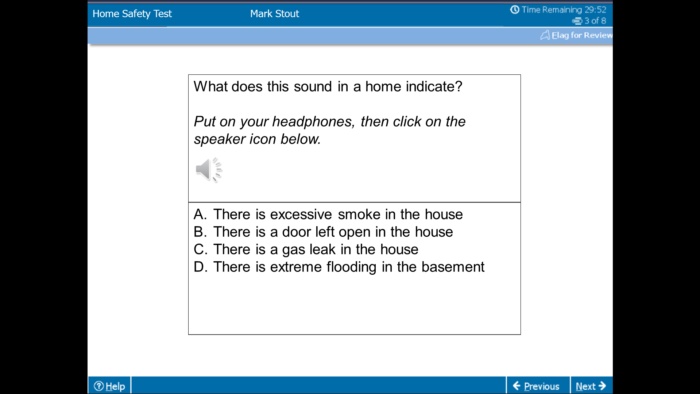From the Item Bank |
||
The Professional Testing Blog |
||
Audio – Why, When, and How to Use This Item TypeDecember 16, 2016 | |Overview In a typical Audio (AU) item a sound file is included within the stem of a multiple choice item, or multiple response, item. A variant of the audio item type might include more than a single sound file in the stem, or might use audio clips as the response options. Since a substantial amount of cognitive work involves the task of listening, audio items may be a useful addition to an exam. When to Use Music and world language assessments have traditionally included audio, while other content areas have added audio more recently. The audio clips may include either speech or non-speech sounds. Assessments that include the speech form may use audio to assess interpersonal communications or related soft skills such as management styles and professional ethics. Many exam committees report that these areas of a test blueprint can be difficult to measure well in text items, without cuing the examinees. Audio items, like video items, provide more naturalistic context that can support the measurement goal. While video provides richer context, some audio items do include a still image of the person or people speaking. Audio can also be a useful alternative in low bandwidth situations. In addition, a substantial amount of non-speech audible information can be appropriate for including on an exam. Beyond music, these non-speech sounds might include recordings of heart or lung sounds, and the sounds produced by some types of diagnostic equipment or machinery. Finally, audio is also used in some situations to provide voice-over accommodations. The item (and other screen elements) may be read aloud to the examinee. While audio is included within an exam in this type of application, the audio is not part of the construct being measured.
Note: Adapted from Parshall, C.G., & Cadle, A. (2015, March). How to identify, develop, and implement innovative items. Presented at the annual meeting of ATP, Palm Springs, CA, March 1-4. Issues to Consider A variety of issues arise when audio is included in an assessment. Decisions may need to be made about the number of speakers used in any given audio file, the maximum allowed length for an audio file, the type of information that should be conveyed through audio, the level of examinee control over the sound files that should be provided in the CBT software, and the appropriate level of realism that should be reflected in the sound files. Each of these decisions may have implications for item writing which should then be addressed through the specification of clear item writing guidelines. There is also a need, in any application of audio, to provide some type of accommodation for examinees with hearing disabilities. In many instances the best accommodation for speech sounds would be a text script. For non-speech sounds a written description of the sound could be provided. For example, rather than an audio clip of lung sounds, the item might indicate that the sound heard was “crackles.” Summary Audio is clearly an area where technology expands the construct areas we can measure. When a test construct includes skills related to listening, the audio item type is well worth considering.
This post is part of the series “Alternative Item Types.” More information about item writing guidelines for the audio item type can be found here. Tags: Alternative Item Types, ATP 2018, ATP17, audio, Item Type, Item writingCategorized in: Item Type |
||



Comments are closed here.